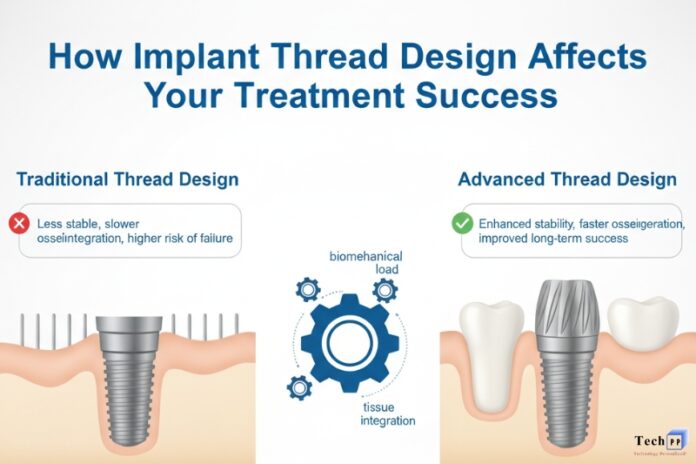Implant Thread Design! Dental implants offer a successful, permanent solution for missing teeth, boasting over 95% success rates due to careful engineering and biomechanical design. A critical factor in this success is thread design, which directly influences how the implant integrates with bone tissue, distributes mechanical forces, and maintains long-term stability.
Basic Concepts of Implant Biomechanics
1. Osseointegration: The Foundation of Success
Osseointegration represents the direct structural and functional connection between living bone and the implant surface. This biological process depends heavily on mechanical stability during the healing phase. Thread design influences this critical period by controlling how forces transfer from the implant to surrounding bone tissue.
The geometry of implant threads creates specific contact patterns with bone, affecting the initial mechanical interlock that prevents micromovement during healing. Research shows that movements exceeding 100-150 micrometers can disrupt the delicate healing process and prevent proper osseointegration.
2. Load Distribution Patterns
Dental implants must handle significant mechanical forces during function, including vertical compression from biting and lateral forces from chewing motions. Thread design determines how these forces distribute throughout the supporting bone structure.
Effective load distribution prevents stress concentrations that could lead to bone resorption or implant failure. The thread configuration acts as a mechanical interface that spreads forces over a larger bone surface area, reducing peak stress levels and promoting long-term stability.
3. Stress Concentration Factors
Sharp thread angles and abrupt geometric transitions can create stress concentration points in the surrounding bone. These high-stress areas may exceed the bone’s adaptive capacity, leading to localized bone loss or implant complications.
Understanding stress distribution patterns helps clinicians select appropriate thread designs for different bone types and loading conditions. Dense cortical bone responds differently to thread geometry than softer trabecular bone, requiring tailored approaches for optimal outcomes.
Types of Implant Thread Designs
1. Thread Configuration
V-threads feature a triangular cross-section with sharp apical angles, typically ranging from 30 to 60 degrees. This design provides excellent cutting efficiency during placement and creates strong mechanical retention in dense bone types.
The sharp thread profile generates high insertion torque values, making V-threads particularly suitable for immediate loading protocols where primary stability is crucial. However, the sharp angles can create stress concentration points that may influence long-term bone response.
2. Square Thread Design
Square threads present a rectangular cross-section with flat thread tips and perpendicular side walls. This configuration maximizes the contact surface area between the implant and bone, distributing forces more evenly across the thread interface.
The increased surface contact reduces stress concentrations while maintaining good initial stability. Square threads perform particularly well in softer bone types where maximizing bone-implant contact is essential for primary stability.
3. Buttress Thread Pattern
Buttress threads combine an angled cutting face with a perpendicular supporting surface. This asymmetrical design optimizes both insertion characteristics and load-bearing capacity, providing efficient placement with excellent resistance to withdrawal forces.
The angled cutting surface facilitates implant insertion while the perpendicular face provides superior resistance to functional loads. This dual-purpose geometry makes buttress threads versatile for various clinical situations.
4. Reverse Buttress Threads
Reverse buttress designs feature the opposite orientation, with the perpendicular surface facing the implant apex. This configuration emphasizes insertion efficiency while maintaining good retention characteristics, particularly in challenging anatomical situations.
Biomechanical Advantages and Disadvantages
1. Initial Stability Considerations
Thread pitch—the distance between adjacent threads—significantly affects initial stability. Finer thread pitches provide more threads per unit length, increasing bone-implant contact area and mechanical retention. However, very fine threads may compromise insertion efficiency and increase placement time.
Coarser thread pitches facilitate faster insertion but may reduce initial stability in soft bone conditions. The optimal pitch depends on bone density, implant length, and loading requirements. All-on-X dental implants, like those in Ocala, FL, often utilize specific thread designs optimized for immediate loading protocols.
2. Stress Distribution Patterns
Different thread geometries create distinct stress distribution patterns in surrounding bone tissue. V-threads tend to concentrate stresses at thread tips, potentially leading to localized bone remodeling. Square threads distribute forces more uniformly but may generate lower initial retention values.
Buttress threads offer a compromise, providing good initial stability while minimizing stress concentrations. The asymmetrical design allows for controlled stress distribution that supports both immediate stability and long-term osseointegration.
3. Osseointegration Dynamics
Thread design influences the osseointegration process through its effects on bone-implant contact patterns and mechanical stimulation. Optimal thread geometry promotes stable mechanical conditions that support bone formation while avoiding excessive stress levels that could trigger bone resorption.
The microgeometry of thread surfaces also affects cellular response during healing. Smooth thread flanks may support different cellular activities compared to roughened surfaces, influencing the quality and speed of osseointegration.
Clinical Implications
1. Surgical Placement Considerations
Thread design directly impacts surgical placement procedures. Sharp, aggressive threads may require more precise drilling protocols to prevent overheating or excessive insertion torque. Gentler thread profiles allow for more forgiving placement techniques but may sacrifice some initial stability.
Insertion torque values provide valuable feedback about thread engagement with bone tissue. Optimal torque ranges depend on thread design, bone density, and implant dimensions. Understanding these relationships helps clinicians achieve predictable primary stability.
2. Healing Time Variables
Different thread designs may influence healing timelines through their effects on mechanical stability and stress distribution. Implants with superior initial stability may support shorter healing periods or immediate loading protocols.
However, excessive initial stability achieved through aggressive thread designs might create stress concentrations that actually delay osseointegration. The goal is achieving optimal rather than maximum initial stability.
3. Prosthetic Outcome Factors
Thread design influences the long-term maintenance of peri-implant bone levels, which directly affects prosthetic outcomes. Designs that minimize stress concentrations tend to preserve marginal bone better, supporting long-term aesthetic and functional results.
The biomechanical properties established by thread design also affect the implant’s ability to support different prosthetic loading conditions, from single crowns to complex multi-unit restorations.
Conclusion
The complexity of implant biomechanics underscores the importance of understanding how thread design influences treatment outcomes. Successful implant therapy requires matching thread characteristics to specific clinical conditions, including bone quality, loading requirements, and patient factors.


